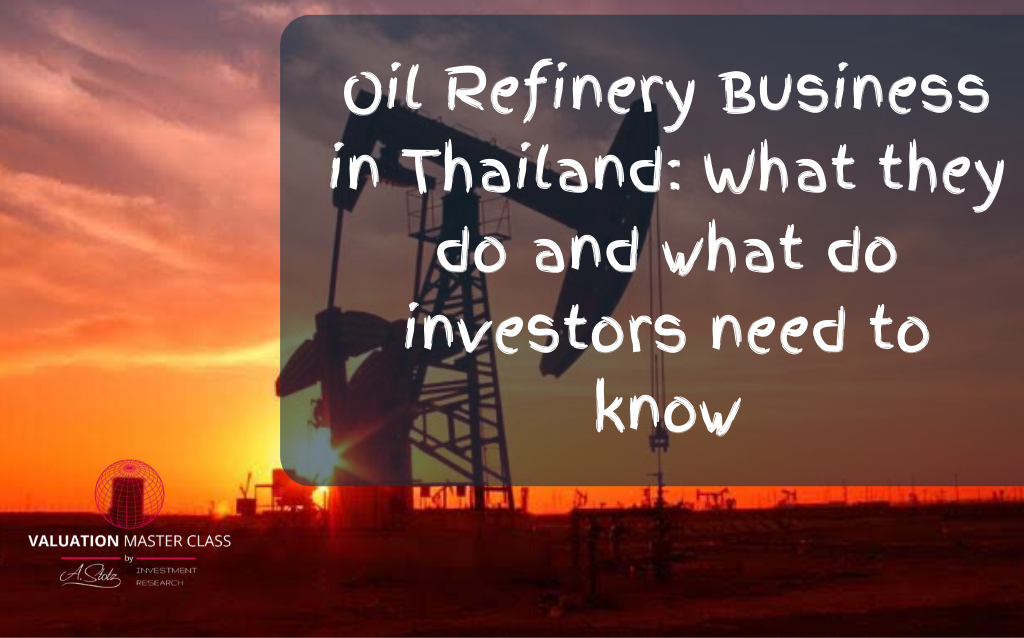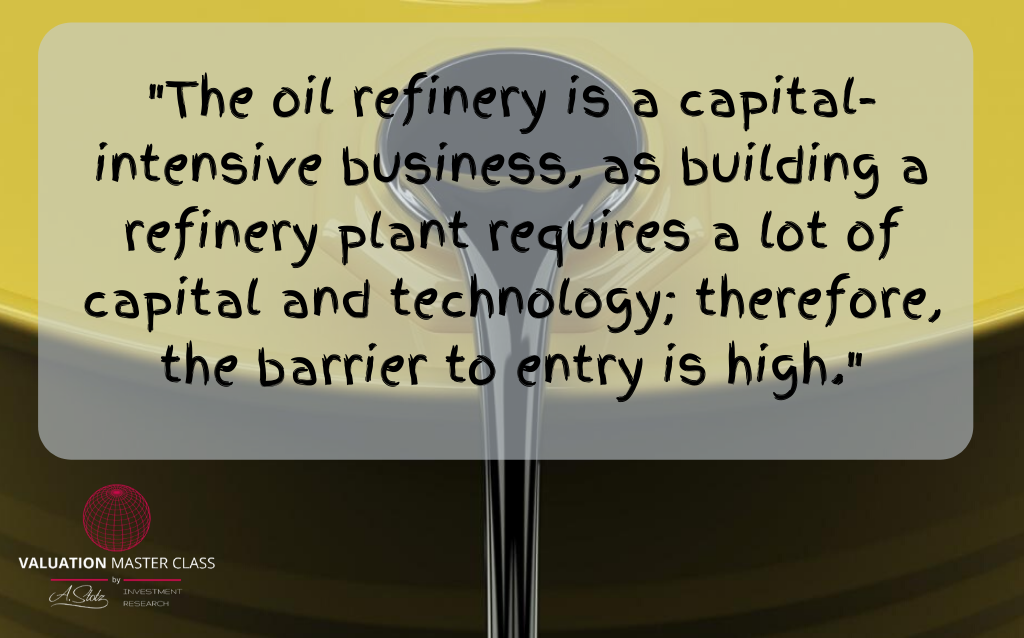Oil Refinery Business in Thailand: What they do and what do investors need to know

This is a Valuation Master Class student essay by Tossapon Rodyim from May 25, 2019. Tossapon wrote this essay in Module 3 and has since completed all five modules of the Valuation Master Class.
The oil refinery is one of the major businesses in Thailand with a market capitalization over 600 billion THB. The main business of oil refinery is to convert crude oil which is extracted from underground or under the sea to petroleum products such as gasoline, diesel, jet fuel and fuel oil which are fuel for cars, planes, ships and other industrials. In order to understand and invest in oil refineries companies, investors need to know the nature of the business and factors that affect the profitability of oil refineries which include crude oil price, price of petroleum products, gross refinery margin (GRM), crack spread and stock gain/loss.
Oil refineries convert crude oil to a variety of petroleum products with different values
The oil refinery is a process that separates various substances of crude oil to many useful petroleum products and petrochemical products for various purposes. The companies use crude oil as raw material, produce petroleum products through processes in oil refinery plants and sell them. The output of the refining process comprises many kinds of petroleum products such as gasoline, diesel, jet fuel, fuel oil and many kinds of petrochemical products. The output is mixed with different kinds of petroleum products with different values depending on the source of crude oil that is used as raw material. For example, Brent crude oil can be converted to a lot of gasoline which is a high-value product and some of the lower value products like fuel oil, while crude oil from Dubai can be converted to more diesel, fuel oil and less gasoline. The oil refinery is a capital-intensive business, as building a refinery plant requires a lot of capital and technology; therefore, the barrier to entry is high.
There Are Two Types Of Refinery; Simple And Complex
- Simple refineries have no control over what output will be. The output products depend on the substances in crude oil that is used as raw material. For example, certain types of crude oil will be converted into a lot of fuel oil which is a lower value compared to gasoline.
- Complex refineries can improve the output from lower value petroleum products like fuel oil to higher-value products like diesel and gasoline. Each complex refinery has a different capacity to improve petroleum products depending on the level of complexity. The level of complexity is measured by Nelson Complexity Index (NCI). High NCI refinery can produce many high-value outputs and can take crude oil from different sources like WTI, Brent and Dubai as raw material. The downside of complex refineries is that they’re very expensive to build. Oil refineries in Thailand are mostly complex refineries.
The cost structure of the business is mostly variable costs. The cost of raw material, in this case is crude oil, accounts for 75-85% and the rest of the costs are depreciation, labor, utilities and others. As of 2018, there’re 6 oil refinery companies in Thailand and the capacity to refine crude oil is at 1,234,500 Barrel/day. PTTGC, TOP and IRPC are the top 3 biggest oil refineries in Thailand which have the capacity at 62% of total capacity in Thailand and they’re subsidiaries of PTT. The other 3 refineries are ESSO, SPRC and BCP which has the capacity at 14%, 13% and 10% respectively.
Factors that affect oil refinery business are the price of crude oil, price of petroleum products, GRM, crack spread and stock gain/loss
There are many factors that investors need to understand before investing in an oil refinery company. These factors affect the profitability of the business and indicate how well the companies are going to perform in the future. The factors are as follows.
- Crude oil can be categorized by density and sulfur level. Low-density crude oil is called light crude and it’s more expensive than heavy crude which has a higher density. Low sulfur crude has sulfur less than 0.5% and it’s called sweet crude which has better quality and more expensive than high sulfur crude which is called sour crude. The high-quality crude oil is called light sweet crude which is from Brent and WTI while Dubai has Light sour crude oil which is lower quality. There are 3 benchmarks of crude oil price which are WTI, Brent and Dubai. West Texas Intermediate (WTI) is crude oil extracted from the USA while Brent is from the North seas, Europe, Russia and Africa. Dubai is an oil price benchmark from the Middle East. Brent and WTI crude are light sweet crude and it is ideal to be converted to gasoline while Dubai crude is heavier and sourer making it suitable to be converted to diesel. The price of crude oil affects the profitability of oil refining businesses as the cost of raw material accounts for 75-85% of the total cost. Crude oil price is driven by many factors that affect oil demand/supply. Factors that affect oil supply are OPEC supply cut, plant maintenance, new plants, geopolitical tensions etc. Demand for oil will increase from good economic outlook, USD depreciation, cold weather etc.
- The price of petroleum products directly affects the revenue of oil refinery. The price of petroleum after refining (Ex-refinery prices) in Thailand is referenced to the Singapore Monetary Exchange (SIMEX) which already reflected the demand/supply of petroleum products in ASEAN and the cost of refining.
- Gross refinery margin (GRM) is like an average profit margin from all the petroleum products extracted from crude oil. GRM is spread between the total market value of petroleum products output and the cost of refining crude oil. Increases in GRM is beneficial to oil refining. GRM will increase if the price of petroleum products is rising faster or decreasing slower than crude oil. Also, a higher refinery capacity utilization rate will increase GRM and complex refinery with high NCI that can produce a lot of high value petroleum products that will have high GRM.
- The crack spread is the difference between the price of crude oil and petroleum products. The spread is like a profit margin for oil refineries and it’s different from GRM that it does not include the cost of refining such as operation costs, labor, transportation and others. The spread widens and tightens from various factors such as weather seasonality, crude supplies, demand/supply of petroleum products and geopolitical tensions etc. The wider spread is beneficial to oil refineries. Oil refineries can hedge crack spread risk by trading crude oil futures and petroleum products futures.
- Stock gain/loss: Oil refineries often stock crude oil to use as raw material. The rise and fall of crude oil prices will make the market value of crude inventory up and down resulting in stock gain/loss for oil refineries. When crude oil price falls sharply, oil refineries must book stock loss which will lower profitability for the period and if crude price rises, the stock gain is booked.
To conclude, oil refineries business is to convert crude oil to various petroleum products. There are 6 oil refineries companies in Thailand with complex refineries. The cost of crude oil accounts for 75-85% of total costs and there are many kinds of crude oil. The price of petroleum products in Thailand is a reference to SIMEX prices. GRM and crack spread are profitability margins for the business. The investor should watch out for the rise and fall of GRM which is caused by oil price and world economy outlook. The ideal time to invest in oil refinery companies is when the crude oil price is rising and petroleum products price is rising faster caused by the good economy, tourism boom etc. The spreads should be widening, and the companies will book stock gain from the wider crude oil price which increases profit even higher. These are the factors that investors need to watch out for.
References
- https://www.krungsri.com/bank/getmedia/aceda7f5-312d-4aa2-bbfa-2bbcdd93cb1b/IO_Refinery_190329_TH_EX.aspx
- https://res.scbsonline.com/stocks/extra/34176_20181011084359.pdfhttps://res.scbsonline.com/stocks/extra/34176_20181011084359.pdf
- https://www.set.or.th/dat/vdoArticle/attachFile/ID106.pdf
- http://www.eppo.go.th/index.php/en/en-energystatistics/petroleum-statistic?orders[publishUp]=publishUp&issearch=1
- http://www.pttplc.com/th/Media-Center/Energy-Knowledge/Documents/MD25%20knowledge02/petro_02.pdf
- https://corporatefinanceinstitute.com/resources/knowledge/trading-investing/crack-spread
- https://www.cmegroup.com/education/articles-and-reports/introduction-to-crack-spreads.html

